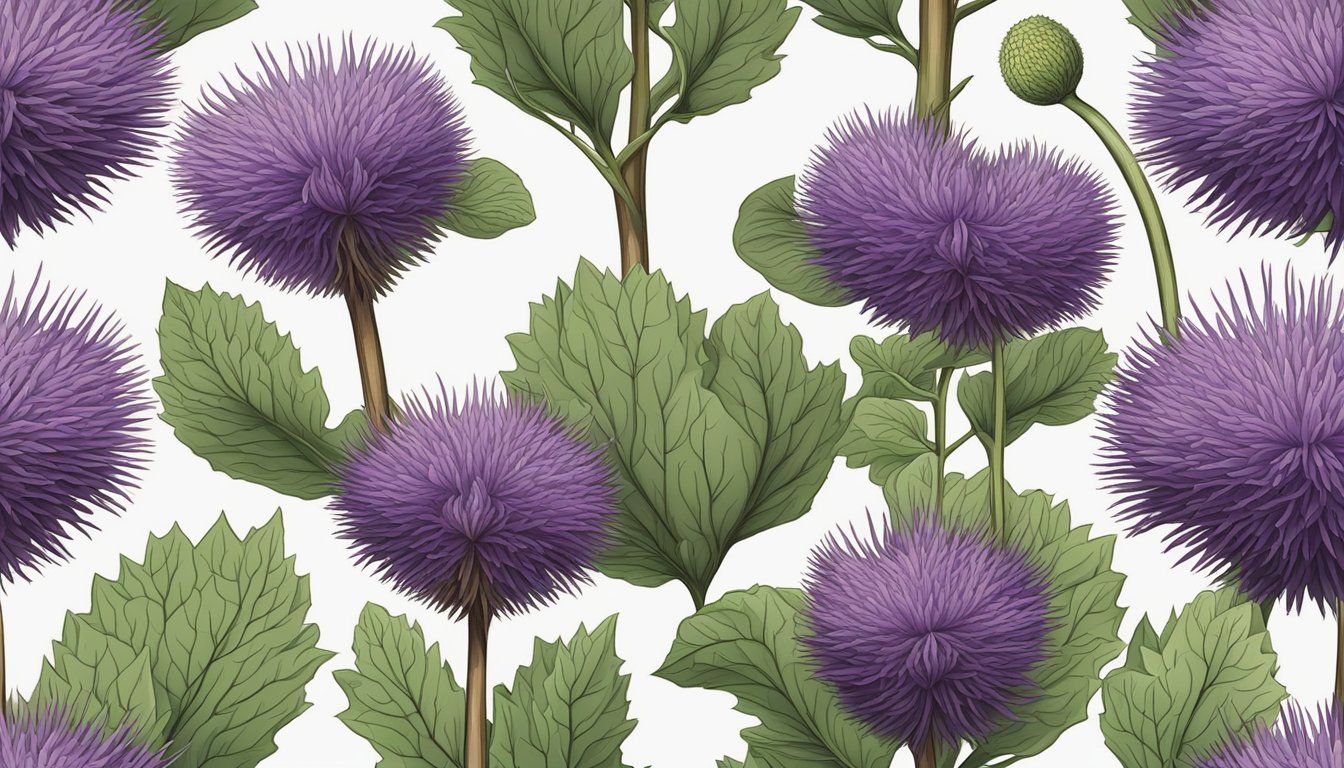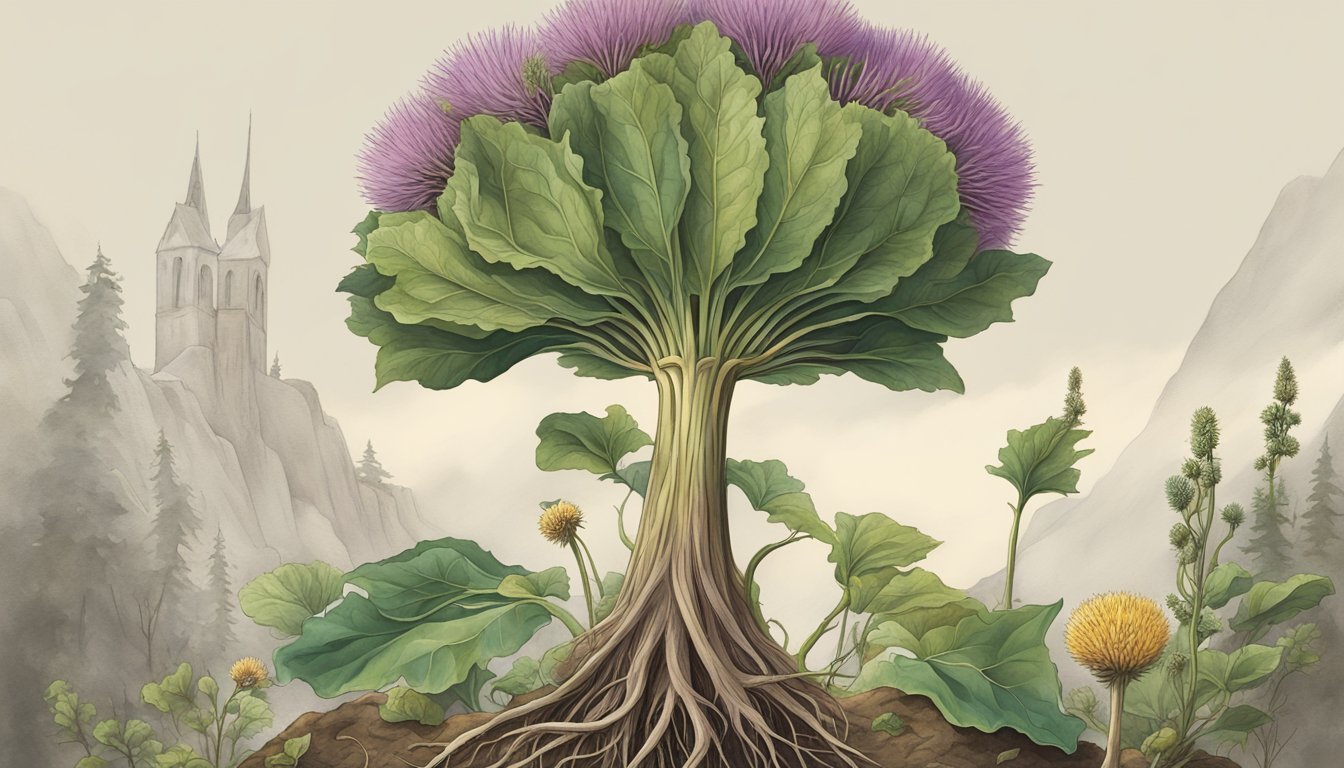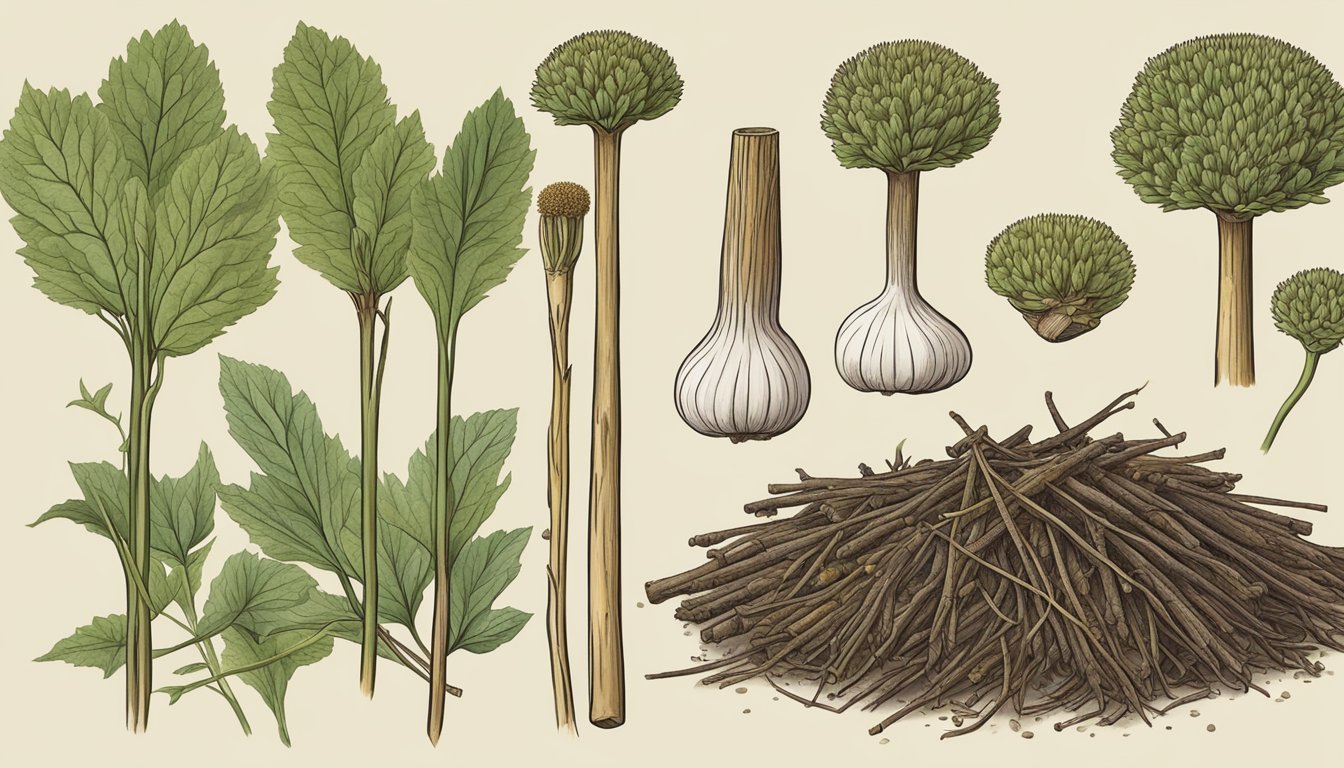The Protective Qualities of Burdock Root
A Cross-Cultural Analysis
Burdock, a plant with the scientific name Arctium lappa, is much more than a common weed. This biennial plant, belonging to the asteraceae family, is recognized by its broad heart-shaped leaves and purple flowers that bloom in its second year. Originating in Eurasia, burdock has been naturalized worldwide and often misunderstood as a mere roadside nuisance. However, its long, slender taproot has secured a place for burdock in various cultural pharmacopeias due to its protective and health-promoting properties.
Throughout history, different cultures have harnessed the root of burdock for its purported medicinal benefits. Traditional use in herbal medicine spans continents, with burdock being employed to purify blood, as a diuretic, and even as a topical remedy for skin conditions. The plant's seeds have also found their way into traditional practices, though the root remains the most celebrated part for its potential health-promoting compounds.
In modern times, the interest in burdock extends beyond folk medicine. Scientific research delves into the root’s composition, revealing a rich profile of nutrients and compounds such as inulin, a prebiotic fiber, various amino acids, phenolic acids, and potent antioxidants. These nutritional and nutraceutical properties suggest why burdock may offer protective qualities against certain diseases, backing up some of the traditional claims associated with its use. Despite its unassuming appearance, the burdock root is a wellspring of qualities that resonate across cultures, emphasizing the bridge between traditional knowledge and modern science.
Burdock root, celebrated for its protective qualities, has been a revered botanical in traditional wellness practices for its potential to promote health and vitality. This remarkable root has been cherished for its protective properties, offering a natural shield for overall well-being. When combined with beetroot and chia seeds, Burdock root provides a holistic approach to supporting health, reflecting its enduring appeal in ancient and modern wellness traditions.
Furthermore, the addition of goldenseal, frankincense and myrrh, and black seed oil further complements the protective potential of Burdock root, contributing to its reputation as a versatile and effective natural remedy. Additionally, the incorporation of peppermint and maca root into wellness practices alongside Burdock root has expanded the spectrum of potential health benefits, underscoring the enduring appeal of this remarkable botanical.
In conclusion, Burdock root continues to be celebrated for its protective qualities, offering a natural solution for promoting well-being. Whether combined with beetroot, chia seeds, goldenseal, frankincense and myrrh, black seed oil, peppermint, or maca root, Burdock root remains a symbol of health and vitality, embodying the rich heritage of natural health practices.
Historical Significance and Cultural Uses
Burdock root's traditional use as a remedy spans across many cultures, primarily noted in Asia and Europe. Acknowledged by herbalists for its health benefits, it has played a consistent role in traditional Chinese, Japanese, and European medicinal practices.
Burdock in Traditional Chinese Medicine
In Traditional Chinese Medicine (TCM), burdock root, known as "niúbàng," is cherished for its potential to balance internal heat. Properties: It is considered to have a cooling effect on the body and is used to clear heat and remove toxins. Uses: Health ailments such as sore throats, colds, and even fevers are often treated with this potent herb.
Usage in Japanese Practices
Burdock Root (Gobo): This root vegetable is a staple in Japanese cuisine and is integral to various dishes such as kinpira gobo, a stir-fried dish flavored with soy sauce and mirin. Cultural Relevance: Beyond its culinary use, it is held in high esteem by Japanese herbalists for its potential health-contributing properties, including its possible diuretic effects and enhancement of digestion.
Burdock in European Folk Medicine
Burdock has a storied past in Europe, where it was commonly incorporated into herbal formulas. Herbalists' Perspective: It was often utilized for its purported ability to purify the blood and support skin health. Medicinal Preparations: Traditionally, burdock root has been used in teas, tinctures, and decoctions aimed at addressing various health complaints.
Botanical Profile of Burdock
This section provides an insightful glance into the botanical characteristics of burdock, focusing on its morphology, nutritional makeup, and traditional harvesting methods.
Morphology and Classification
Burdock, scientifically known as Arctium lappa, is a biennial herbaceous plant belonging to the genus Arctium in the family Compositae. In its first year, the plant forms a low rosette of leaves that transition into a tall, branched stem in the second year. Its broad leaves exhibit a wavy margin and can appear hairy underneath. This plant produces flowers that are typically purple and occasionally white, encased in a bristly involucre. The taproot system is deep and expansive, indicative of the plant's strong anchorage and ability to access nutrients from the soil.
Nutrient Composition
The root vegetable of burdock is a haven of nutritional constituents. It contains an impressive array of:
Polysaccharides: In particular, inulin, a prebiotic fiber
Proteins and amino acids
Phenolic compounds: Known for their antioxidant properties
Essential minerals: Such as potassium, magnesium, and iron
A variety of vitamins: Including vitamin C and B vitamins
This combination of nutrients contributes to the root's reputation as a healthful food.
Harvesting and Preparation Methods
The harvesting of burdock root typically occurs in autumn when the concentration of bioactive compounds is at its highest. The roots are carefully dug out to avoid breaking, as the taproot can be both long and delicate. Traditional preparation methods often involve cleaning, peeling, and can include slicing the taproot into thin strips. Drying or pickling are methods employed to preserve the root for later use. In culinary applications, it is generally cooked and can be consumed as a root vegetable, much like carrots or parsnips.
Health Benefits and Nutraceutical Properties
Burdock root, recognized for its diverse health benefits, has been a cornerstone in traditional medicine across various cultures. It boasts a rich profile of nutrients and bioactive compounds that support detoxification processes, skin health, digestive wellness, and combat inflammation.
Detoxification and Liver Health
Burdock root is traditionally used to promote liver health and detoxification. The liver is responsible for filtering blood from the digestive tract, detoxifying chemicals, and metabolizing drugs. Burdock root contains compounds that may help in these processes, aiding the liver in eliminating toxins from the body and supporting overall liver function.
Burdock Root in Skin Care
Skin health benefits from burdock root due to its potential role in treating skin conditions like eczema, acne, and psoriasis. The herb’s nutraceutical properties contribute to its use in skin care, as it can help address inflammation and bacterial imbalances. Herbalists believe burdock root can promote healing in skin, offering a natural remedy for maintaining healthy, clear skin.
Digestive System Support
Burdock root is rich in inulin, a type of dietary fiber that offers considerable support for the digestive system. Inulin aids digestion by increasing the efficiency of gut bacteria, which in turn can lead to improved gastrointestinal health. This nutraceutical fiber also contributes to a sensation of fullness, potentially benefiting weight management.
Antioxidant and Anti-inflammatory Impact
The root is a substantial source of antioxidants, which may reduce oxidative stress and combat cellular damage. Its anti-inflammatory effects are also notable, potentially mitigating indicators of inflammation in the body. Regular consumption of burdock root thus may have protective implications for health, contributing to its status as a valuable medicinal plant.
Culinary Applications of Burdock Root
Burdock root is a versatile ingredient in many culinary traditions, offering a distinct flavor and crunchy texture. It is enjoyed in a wide range of dishes from teas to stir-fries.
Burdock in Contemporary Cuisine
Contemporary chefs incorporate burdock root into modern dishes due to its nutritional value and unique taste. Often found in health food stores, burdock can be boiled, stir-fried, or even pickled. Here is a basic outline of how it's used in contemporary foods:
Stir-Fries: Thinly sliced burdock root adds a crunchy texture and a slightly sweet, earthy flavor to stir-fries.
Salads: Julienne burdock can be a nutritious addition to salads.
Teas: Burdock root can be dried and steeped to create burdock tea, a beverage believed to have detoxifying properties.
Supplements: Ground burdock root is available as a powdered supplement, and as a tincture for its health-promoting properties.
Traditional Recipes and Preparations
In traditional cuisines, burdock root has been prepared in a variety of ways, reflecting its importance across cultures:
Soups and Stews: In Asian cultures, burdock is often simmered in soups and stews.
Boiled: The root may be peeled, sliced, and boiled until tender, often served with a dash of soy sauce or mixed with other vegetables.
Pickled: In Japanese cuisine, burdock is pickled in vinegar, sugar, and honey to make a dish known as "kinpira gobo."
Diet Staple: It has historically been a staple in the diet for its abundance and ease of cultivation in well-draining, fertile soils.
Burdock in Modern Herbalism and Supplements
Burdock root continues to be a prominent herb in modern herbalism, often found in supplement forms such as capsules, tinctures, and extracts, which are recognized for their potential health benefits.
Burdock Root as Herbal Supplement
Herbalists frequently recommend burdock root as a dietary supplement for its rich content of dietary fiber and compounds such as quercetin and luteolin. It is commonly available in various preparations:
Capsules: Easy to consume and typically used for convenience.
Tinctures: Liquid extracts favored for their rapid assimilation.
Extracts: Concentrated forms which allow for dosage precision.
Supplement brands like Nature's Way, Gaia Herbs, and Solaray have become well-known for their burdock products. When choosing a supplement, consumers are advised to consider product purity, sourcing, and evidence of third-party testing to ensure quality.
Scientific Research and Evidence
Research into burdock root has provided preliminary evidence of its potential health properties, with studies highlighting its role as a natural remedy. Findings suggest that burdock may offer protection against chronic diseases and support healing. Notably, its antioxidants are linked to aging and cellular health.
Studies include:
Liver health: Indicators of enhanced liver function and detoxification support.
Skin health: Research points towards its use in improving skin conditions.
Anti-inflammatory properties: Potential to reduce inflammation markers.
Despite promising results, further scientific research is necessary to conclusively determine the efficacy and therapeutic applications of burdock root in modern herbalism.
Safety and Side Effects
While burdock root is considered safe for consumption and offers various protective qualities, it is essential to be aware of potential side effects and take necessary precautions.
Known Adverse Reactions
Burdock root, when consumed in moderate amounts as a food or medicine, typically presents minimal risk. However, in some individuals, it may cause allergic reactions, especially in those with sensitivities to the Asteraceae/Compositae family. Allergic symptoms can range from simple skin irritation to more severe responses like anaphylaxis.
The root extract and tincture, being concentrated, have been associated with cases of dermatitis. Furthermore, due to its diuretic effect, burdock could potentially increase the risk of dehydration or electrolyte imbalances if overconsumed.
Cautions and Contraindications
People with pre-existing medical conditions should be cautious. Specifically, those with bleeding disorders should avoid burdock, as it might slow blood clotting. Those scheduled for surgery are advised to stop taking burdock root at least two weeks prior to reduce the risk of excessive bleeding.
Pregnant women might consider avoiding burdock since there is insufficient evidence regarding its safety during pregnancy. It's also prudent for individuals on diabetes medications to consult a healthcare provider due to burdock's potential to lower blood sugar levels, which might necessitate medication adjustments.
Burdock might interact with medications that increase sensitivity to sunlight (photosensitizing drugs), leading to an exaggerated sunburn reaction. Lastly, due to its natural anti-inflammatory properties, burdock could theoretically attenuate the effectiveness of anti-inflammatory medications.
People considering the use of burdock in any form should discuss it with a healthcare provider to mitigate the risk of adverse side effects and interactions with other medications. It's particularly important to ensure that no toxins or contaminants are present, as burdock's resemblance to belladonna nightshade plants poses a risk of accidental contamination.
Global Significance and Sustainable Practices
Burdock root—respected for its nutritional and protective properties—holds a notable place in various cultures and sustainable agricultural practices due to its adaptability and low environmental impact.
Conservation and Biodiversity
Biodiversity Conservation: Burdock, being a hardy weed that can grow in disturbed soils, plays a role in supporting local ecosystems. Its presence in North America and Eurasia, amongst other regions, showcases its adaptability and natural integration into local biotas. Notably, burdock contributes to soil health and offers a habitat for wildlife, potentially aiding conservation efforts.
Role in Traditional Medicine: Throughout history, cultures have recognized burdock's potential in supporting health, with particular attention to its reputed abilities to help address conditions like cancer. While such claims require scientific validation, this traditional usage underscores the plant's cultural significance and the need to preserve its variety in the wild.
Cultivation and Environmental Impact
Sustainable Cultivation Practices:
Soil Requirements: Preferring well-draining, fertile soil, burdock exemplifies sustainable agriculture through its minimal soil degradation and adaptability to grow in varied conditions.
Low-Input Crop: As burdock thrives in natural conditions with limited need for fertilizers or pesticides, its cultivation aligns with sustainable practices, minimizing the environmental impact.
Natural Growth as a Weed:
Disturbed Areas: Burdock often establishes itself in disturbed areas where it can become prolific, highlighting its role as a weed. Even as a weed, it contributes to the stabilization of the ecosystem and demonstrates an intertwined relationship with the local environment.
By acknowledging the cultural and natural significance of burdock root, conservationists and agriculturists foster biodiversity, while sustainable practices to cultivate and manage this resilient plant help to mitigate the environmental impact.
Conclusion
Throughout history, burdock root (Arctium lappa L.) has gained widespread recognition for its versatility in medicinal and protective applications. Cultures across Europe and Asia have utilized the root for its nutritional value as well as its health benefits. The belief in burdock root’s protective qualities extends beyond its physical health impacts to include spiritual significance in certain traditions.
In medicine, burdock root is noted for its potential liver-protective effects. The liver's role in detoxification is critical, and compounds in burdock root may support this essential bodily function. Acknowledgement of its use in traditional healing practices underscores the importance ascribed to the plant.
Nutritional properties such as proteins, amino acids, and vitamins contribute to its status as a health care product. The root’s antioxidant capacities, attributed to its high content of phenolic compounds, play a role in disease prevention by neutralizing harmful free radicals.
Culturally, burdock is sometimes incorporated into amulets and charms, reflecting its use in warding off negativity and promoting a sense of grounding and stability, linked to its deep growing roots.
In conclusion, burdock root’s role in various cultures points to a deep-seated respect for this plant’s diverse capabilities. As a nutritional food, a traditional medicine, and a symbol of protection, its ongoing use affirms the value placed on natural remedies and their place in holistic well-being.








